|
|
YAMAHA CS-30 SYNTHESIZER
This page is dedicated to the Yamaha CS-30, the monophonic top-of-the-line of
Yamahas CS-series synthesizers. This synthesizer series comprised of the CS-5, CS-10,
CS-15 and the CS-30. These were all monophonic. The polyphonic series comprised of the
CS-50, CS-60 and the classic CS-80, Later came the CS-30M and CS-40 monophonics as well
as the CS-70 polyphonic with some patch saving capabilities and different design.
All the units of this series of vintage synthesizers are very nice and collectable,
but the CS-30 was the largest and most flexible of the monophonic series. If Yamaha had
ever decided to build a large modular system they could have done so using some of the
designs of the CS-series.
In this page I will go through the features of the CS-30, for anyone interested.
General synth architecture
The CS-30 is a classic subtractive, analog synthesizer. The sections of the synth are those
that will be familiar to anyone used to analog programming. However, Yamaha didn't make it
easy for the beginner. The layout of the synth is less than intuitive, and you often lack
some sort of visual guidance to figure out what is going on. Eventually you get the
hang of it. You can see for yourself now.
The CS-30 is a synth that has a dual set of everything, beginning with the oscillators
and ending with two separate outputs. Therefore the synth may be played as two synths in
one box, if you desire so. This opens for some very interesting stereophonic patches, based
on for instance slight differences in envelope times, or on the use of different modus
operandi of the filters.
But the two sets of synth modules also interact, in interesting, unexpected, and sometimes
illogical ways, and this is where it becomes really interesting. There is a wealth of
modulation possibilities. Some of these are unusual, and have tremendous effect.
Also, the modules of the two sets are not entirely identical, meaning that each set of
modules has its own quirks, and when the two quirky sets interact, you just get something
even quirkier.
If this isn't enough, the CS-30 has a number of control voltage and trigger inputs and
outputs, as well as an external signal in.
And if this isn't enough yet, then there is also an internal 8-step sequencer to make things
even more exciting. You sure have a lot of goodies in this package!
It seems that Yamaha decided to use a system that enables audio outputs to be used as
modulation souces. A very good decision in my humble opinion. This means that you will often
see the traditional LFO and envelope modulation sources side by side with audio sources.
This is a very fascination aspect of the synth, as some of the most complex sounds usually
come from modulation of audio with other audio frequencies. This synth has it galore.
One thing I have heard people do is to take the audio output and run it back into the
external input. This may create anything from feedback and distortion to ring modulation,
depending on how you apply the external input.
Another interesting design decision was that properties of signals are not decided at the
source of the signal, but rather at the target of the signal. This means, for instance, that
you can use more than one oscillator waveform, that you may use both polarities of envelopes,
or you may use any LFO waveform anywhere. Cool idea. It also explains why there are so many
knobs on this synth!
Let us begin the walkthrough of the sections of the synth.
PITCH, VCO1 and VCO2
The CS-30 has two oscillators, and a pitch section to control them. In my world of
synthesis, the oscillator section is usually the most interesting one. This is where
all the harmonics are created. No wonder I'm a big fan of Yamahas other wonder, the DX7!
The CS-30 oscillator sections come with plenty of facilities to provide complex and
interesting harmonics. Let's look at it.
OSC1
Available oscillator ranges are 2', 4', 8', 16', 32' and 64'. The oscillator
has switchable control from either keyboard control voltage or sequencer
control voltage. The oscillator generates both sine, saw and square waveforms,
but unlike other synths, the CS-30 oscillators do NOT have a selector for
waveform. Instead all waveforms are generated by the oscillator and the waveform
is selected at the source of the signal. To spice up the waveform situation, there
is a knob enabling pulse widths from 50% to 90%. Pulse width may also be
modulated by LFO. This is where the layout lacks something. The source for PWM
is always the LFO sine wave, although the LFO generates many other waveforms.
The oscillator may also be pitch modulated. For this purpose there are two knobs;
a modulation source selector and a modulation depth. Modulation source may be
one of the five LFO output waveforms; sine, down saw, up saw, square or sample
and hold. You may also select external input as modulation source - a really
wicked feature, as we are here dealing with the oscillator frequency! Not visible
in the oscillator section is the pitch modulation from envelope, which is
allocated to the PITCH section, although it really applies to the oscillators.
The supreme feature of OSC 1 is the cross-modulation from OSC 2. This feature
is responsible for some of the coolest sounds of this synth. The diagram doesn't
say so, but I believe the cross-modulation is hard wired to always use the sine of OSC 2.
|
|
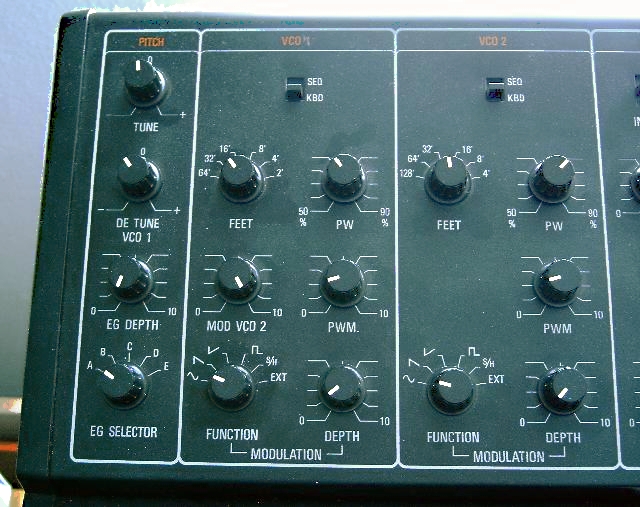
|
OSC2
Same configuration as OSC 1, except no cross modulation, and the available
oscillator ranges are 4', 8', 16', 32', 64' and 128' - the last one being more
like a pulse really! The great thing about it is that the two oscillators may be
modulated by different LFO waveforms, or even controlled by different control
voltage sources. Since the control signal is chosen at the target rather than at
the source, you can do a lot of things you would otherwise only be able to do on
big modular synths using wires.
|
|
PITCH
This section is more important than it appears. It affects the control voltage
sent from the keyboard and the detune between the two oscillators. Here control
voltage may be subjected to envelope control, so that you can make big pitch
sweeps. Again, since modulation choices are made at target rather than source,
you may here select the envelope and envelope polarity freely, as well as the modulation
amount. The pitch modulation applies to both oscillators, unless the oscillator
has selected sequencer as modulation source. So actually you can make a
note that is cross modulated by another oscillator that is pitch swept! And it
doesn't stop there BTW, but I'll get back to that.
Detune is obviously important when cross modulation is applied to OSC 1.
|
|
VCF1 and VCF2
One of the distinguishing features of the Yamaha CS-series is the filters.
The CS filters are not spectaular sounding 4-pole ones with self-oscillating resonance,
like the Prophets, Moogs and Oberheims of this world. They are 12 db/oct, non-self-oscillating,
and their strengs lie in their delicacy. Given a harmonically complex signal, the CS filters
are able to play the harmonics of the original signal. It is hard to explain in
plain words, but it sounds great!
The filter section is also the place where the quirkiness of the CS-30 kicks in. The two
filter sections are rather different, and there are knobs to cross signal from one set of
modules over to the other. Again Yamaha applied the decision to select near target rather
than by the source, so both filters produce all its three types of filtering at the same
time! Furthermore some rather strange, and appearingly random limitations have been
implemented.
Let's get into the filter section.
VCF1
The first filter may select its audio signal from two sources simultaneously.
The first input source is selectable between the saw and the square of VCO 1,
and the saw of VCO 2. The signal is attenuated through a dedicated knob. The second input
source is selectable between external signal, noise and (again!) the saw of VCO 2.
This input also has a separate attenuator, so we really have a signal mixer in action
here, before the filter 1. However, the presence of two times VCO 2 saw is really
strange. Maybe they wanted the option of combining VCO 1 and VCO 2 saw at the same
time. Who knows?
The filter itself has the obligatory cut off frequency
and a resonance knob. Resonance is NOT resonant! It does not self-oscillate. It
does an incredible job of emphasizing the cut frequency of the signal, however.
Cut frequency may be controlled from many sources. There is a variable keyboard
follow from 0 to 2, with 1 following pitch. There are two modulation sources.
The first is selectable between the five waveforms of the LFO and the external
signal. This selector has its own attenuator. The second is a selectable envelope
and envelope polarity, which also has its own attenuator. Notice again that
external signal may be used to modulate cut of frequency. Another cool detail for
those seeking richer harmonics.
What you can't see is that both filters produce both low pass, band pass
and high pass filtering simultaneously, but the principle of selecting at the target
means that you won't see this before the VCA sections!
|
|
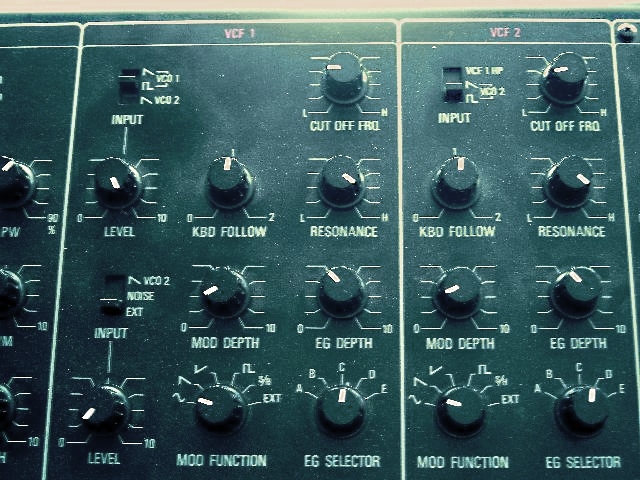
|
VCF 2
The second filter has the same modulation possibilities as VCF 1, but it is
different in the input department. On VCF 2 you may only select between VCO 2
saw or square, or the high pass filter of VCF 1!!! This, in my opinion, has got
to be one of the strangest and most arbitrary decisions I have seen. If they
really wanted VCF 1 as an input source (fine idea BTW), then why not a
five position selector including VCF 1 band pass and low pass as well? And why
is there no attenuator for the input? it is indeed very strange. No doubt that
sending VCF 1 HPF through VCF 2 can create some interesting sounds of filters
interacting, but please, the HPF is the thinnest sounding of the filters.
There is another.. ahem.. undocumented feature of both VCFs worth knowing. The keyboard
tracking also depends on the position of the corresponding VCOs control voltage
selector!!! Why it is so I have no idea, and as far as I am concerned it may
in fact be a design bug, but it is a useful one as it means that there is an implicit
sequencer control of the cut off frequency as well - and this is very useful.
|
|
VCA1 and VCA2
This brings us to the amplifier section. There are two VCAs on the CS-30, and they are
very different from one and other. Again the quirkiness of the synth kicks in. The
desired filtering type of VCF 1 is selected in the VCA 1 section, and the VCF 2 filtering type
in VCA 2, still applying the principle to select near target rather than at source. Also
envelope and gate is selected in the same way.
But that is were the similarities between VCA 1 and 2 stop. Let's look at it.
VCA1
This amplifier essentially works as a mixer followed by voltage control. The
VCF 1 filtering type is selected here, but then only has an effect on the VCF 1
input.
The mixer section may take VCF 1, VCF 2 or VCO 1 sine (sic!) as input. Another
quirk! All three are are attenuated. The decision to include a direct input
from VCO 1 sine is truly strange, but nevertheless very useful to beef up
a sound that might have become very thin and fragile at this point. It makes
it possible to produce some really deep bass sounds too. Not fatness, but
with a lot of boom.
Modulation is restricted to four LFO waveforms plus external signal, and has
a dedicated attenuator. Again, notice the inclusion of the external signal.
This may be used for ring modulation-like sounds.
Envelope modulation is strangely restricted to any of the envelopes, but only
with their positive polarity. Another incomprehendable quirk. Envelope may be
exchanged for gate signal.
|
|
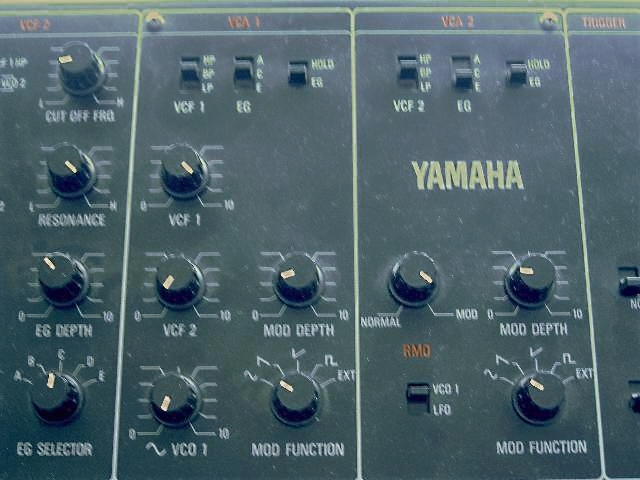
|
VCF 2
The second amplifier has the same filtering type selector for VCF 2 as VCA 1 had.
Also the envelope selector and gate selector is there. Finally the modulation
selector and attenuator are the same. But the VCA 2 does not have an input mixer.
The VCF 2 signal is fed directly, unattenuated, into the VCA. Instead of a mixer
the VCA 2 sports a ring modulator. Ring modulation can be done either with
LFO (sine wave), or with VCO 1 (sine wave). Needless to say that the ring modulator
is another of those cool features that enrich the sound of the synth so much.
|
|
EG1, EG2 and EG3
So now we have seen the signal line. Now it the time to examine the voltage control
generators. The first set of these are the envelopes. The CS-30 is equipped with no
less than three envelopes! What's more, two of them may be used with both positive
and negative polarity.
EG1
The A/B envelope departs from traditional envelope designs by having an
initial level, and attack level, and no sustain level.
Again another Yamaha CS-30 quirk!
Sustain level is implicitly 0 Volt, which relative to the initial level that
may vary between -5 Volt and 0 Volt is a higher level. But this design makes it
possible to have a -5 Volt rest voltage, compared to the traditional envelopes
0 Volt, and this is extremely useful when the voltage is used to modulate LFO.
It means that you can make the LFO loop with extreme timing. It also matters
when EG1 is used for the control of the VCOs as it provides a very wide range
of pitch sweeps.
To widen the range of the envelope it has a switch between normal and x5, which
speeds up slope times five times. So you can make very long sweeps as well as
snappy attacks. Nice feature.
Finally you may select the trigger of the envelope to be either keyboard,
sequencer or external input. Yes, it may be used as an envelope follower!
You can process drum loops through the CS-30!
|
|
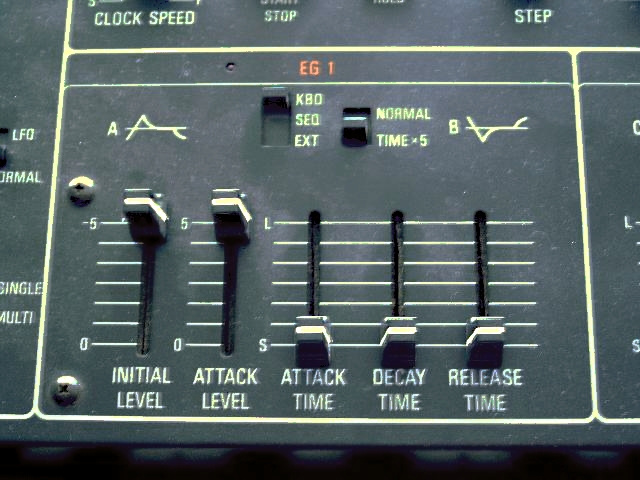
|
EG2 and EG3
The two other envelopes C/D and E are of the more common variety. They share
the same trigger and time buttons as EG1, but otherwise have the traditional
ADSR structure.
(EG3 is not shown, but it is identical to EG2).
|
|
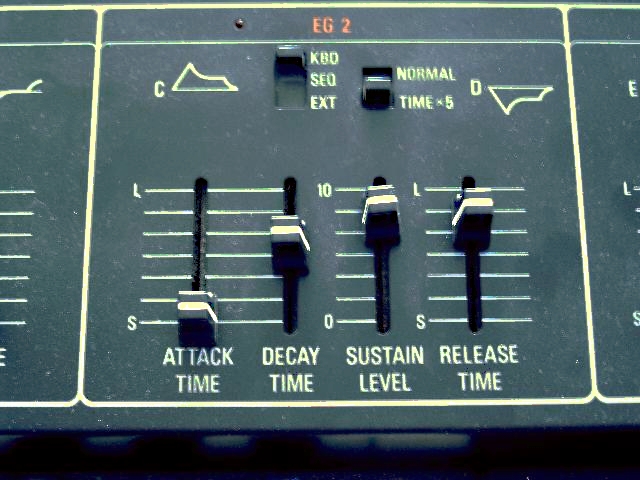
|
LFO and EXTERNAL INPUT
The LFO and external input sections are placed rather unusually to the left of the
keyboard. I suppose Yamaha ran out of vacant space on the panel itself. Usually this is
the place where large pitch wheels and mod wheels are positioned, but not on the CS-30.
There is a pitch bend button, which is fairly impractical, and there is no dedicated
mod wheel! If you want to modulate, you have to grab one (or two) of your favourite
attenuators on the panel. Meaning: You don't do it!
Instead they decided to put the portamento slider here. Well... you get used to it.
But this is not a performers synth, it's a studio synth.
LFO
The LFO has the necessary speed knob, but the interesting thing is that it
also has envelope modulation! You may select between all envelopes and polarities,
and you have separate modulation depth. The effect is enormous. With the right settings
you can make the LFO sweep way into the audio range, and back into slow again.
Think a while about all the targets for LFO modulation. Imagine what you can do with
an audio range sweep. Combine an audio range sweep on VCO 2 with cross-modulation of
VCO 1, and you have a very, very complex sound. Add to that a bit of ring modulation.
This is one of the most central features of the CS-30. With the unusual EG1, the
possibility to pitch sweep LFO into audio, cross-modulaiton and ring modulation,
you really have endless possibilities.
|
|
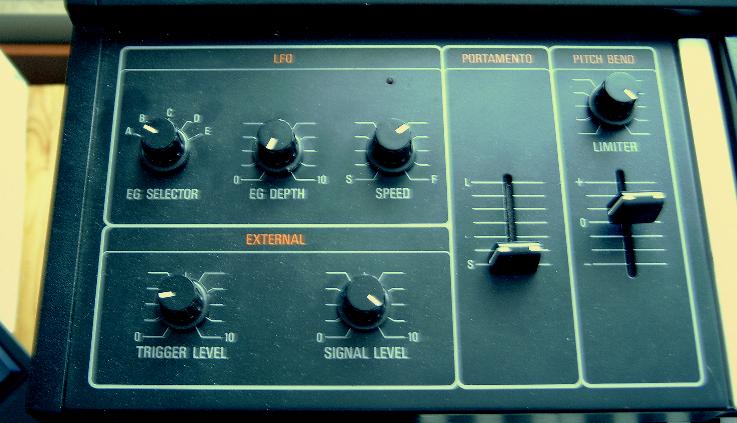
|
EXTERNAL INPUT
As if this wasn't enough, the CS-30 also sports an external input. The panel
provides controls for adjusting signal level and trigering level. So it is
possible to process that drum loop, by trigging envelopes and filters.
Personally I have had great experiences by processing complex harmonic
DX7 sounds. This section of the synth is another strong point.
|
|
8-STEP SEQUENCER
No, we are not done yet. Despite all the other features, Yamaha also decided to fit a
small 8-step sequencer onto the circuit boards of this synth. And thank you for that,
I say! You might think that 8 steps is too little to be useful, but that is in fact not
the case. I have used it to jam extended rythm tracks with more variation that any
techno music track out there. I have provided samples to prove this.
The sequencer is there to provide a beat to the operation and to provide a programmable
modulation source, which may be used as input to for instance cross-modulations. The
possibilities are endless, but it is an efficient way to insert movement to the sounds.
Some of my patches mutate forever due to the difference between sequencer speed and LFO
speed. The 8-step sequencer is an indispensable part of the CS-30.
SEQUENCER CONTROL
The sequencer has its own dedicated internal LFO to provide clock signals.
This is controlled by the clock speed knob. You can select between 1 to 8 steps
of the sequencer.
The remaining buttons work in the following way. The trigger signal can be chosen
between either the clock signal, in which case the big red start/stop button
actually starts and stops the sequencer, or manual trigging, in which case the
red button instead jumps to the next step of the sequence.
The second selector selects between the sources of initial control voltage for
the sequencer. Either you select keyboard CV as the source, in which case the
key CV determines the CV of step 1, or you select normal, in which case CV is
independant, and only relies on step 1.
(In fact I am not sure about this. I've looked at the diagram with the guys
that has serviced the synth, and frankly, we couldn't exactly figure out what
the hell is going on. It seen it do strange unexpected things with the CV here.
Maybe I will alter my description when I fully understand what is going on).
|
|
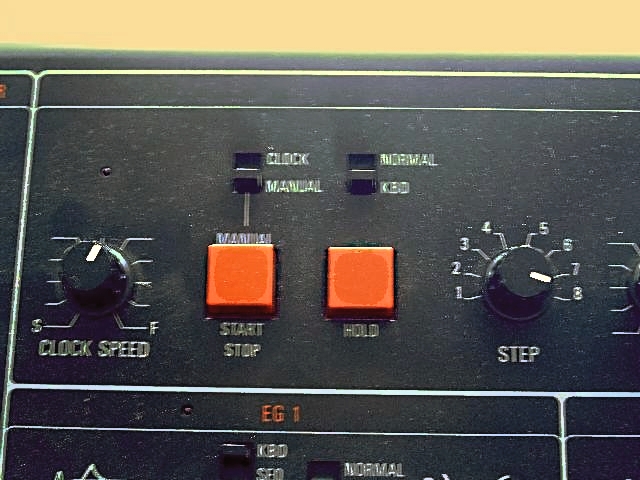
|
SEQUENCER PITCH
The sequencer works as any other old style step sequencer by having 8 knobs
to adjust the control voltage of each step. However, the CV generated by steps
2-8 depend on the CV value of step 1. They are all relative to step 1 CV, which
is both confusing, and at the same time pretty cool. It means that if you have
set up a nice sequence - like the Pink Floyd one from "On the Run" - you
can tweak the entire sequence on the fly using the step 1 knob, much as you would
use a pitch bend. This is nice if you want to throw some live tweaking into an
otherwise simple phrase.
I mainly use the sequencer for simple rythm patterns and as a source of lively
and ever-changing modulation. Since the CV of the sequencer can be sent into all
steps of the chain, and not least into VCO frequency and VCF, the harmonic
variation is immense. Add to this the sequencer trigging envelope, driving
LFO speed, modulating anything in the VCO, VCF, VCA line, it gives even more variation.
Needless to say that here we have hours and hours of fun waiting.
|
|
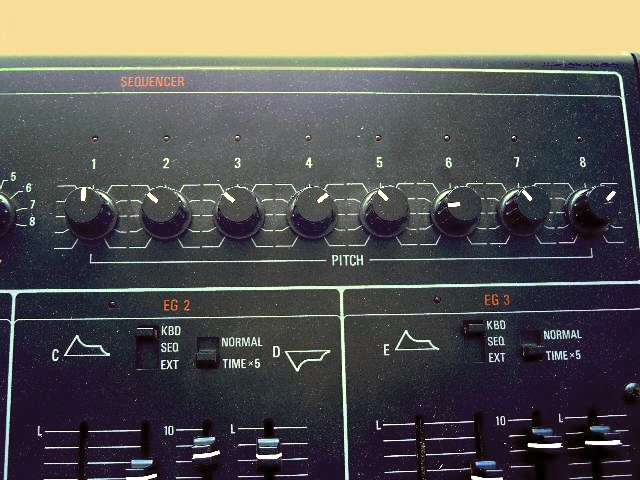
|
WE WANT TO HEAR IT
Yes, of course. Synths are only fun if they can make funny sounds. I will put more samples here later, but let's take this for a starter. Two samples:
| Tinny Drums |
This is a sound played totally hands free. The effect is a result of a chaotic interaction between sequencer stepping and LFO trigging. The envelopes are not trigged at all in this sound, so all the sound that slips through relies only on the rest voltage of the envelope. Strangely it sounds like the LFO is trigging something. A sound that is a total mystery -
even to me. I have the patch written down.
|
| Kraftwerk |
This is another sample based exclusively on one
sequencer jam I made as a one take. Stereo effects of the percussive loop are
all produced as a result of the two individual outputs of the synths. All
variation of the percussion track is done as live tweaking the knobs.
And my deepest apologies for the lame timing of the overdub. The overdubbed
bass line is BTW also played on the CS-30.
|
| Arpy Lead |
A straight forward take on a classic Arp Pro-Soloist sound. The CS-30 does a really convincing Arp sound.
|
| Square Filter Pan |
A nice classic type sound. Notice the nice bottom end of this sound. Using the OSC1 mix-in you can provide
bottom to even heavily filtered sounds. This sound uses slightly different slope setting on the envelopes for
stereo action, and an oscillator per channel.
|
| Filter Sweep |
With this title you would usually expect something based on a slow LFO sweep. This is not the case.
The filters are swept with the envelopes. The interesting thing is that VCF1 is swept with EG2 and VCF2 is
swept with EG3. There are differences to the slope times, so that a spatial stereo effect happens. In this
case I think the left channel uses low-pass filter and the right channel uses high-pass filter.
|
| Filter Sweep RM and FM |
This is the same as Filter Sweep, but now with Ring Modulation applied on VCA2 and cross-modulation
applied to OSC1.
|
| Filter Sweep Multiple Mod |
This is the same as the previous sound, but even more modulation has been applied.
The LFO is modulated by EG1, and the LFO in turn modulates the two signal lines in different places.
|
| How Did I Do This? |
Complete modulation fest. The sequencer is taken in as another modulation source for EG1, in turn affecting
the LFO, in turn affecting lots of stuff, and some more modulation that I just can't remember. Typically for
the sounds you produce on the CS-30 you will be unable to reconstruct a sound like this if you don't write it down!
|
| On The Run |
A take on a classic piece of music, using the CS-30 internal sequencer. The number of timbre tweaks that
could have been applied to the figure is endless.
|
| Robotto |
The CS-30 is the ideal tool for some science finction action. Here a nice robotic/80'ies computer sounding setting.
A proper answer from R2D2.
|
| Tolling Bell |
When you have analog FM, you also have bell-like timbres. Here is an example of that.
|
| Tolling Bell 2 |
Here is another example of bell-like timbres.
|
| RiverFlow |
Inspired by the background noises of one of the sections on Jean
Michel Jarres Equinoxe, here's a strange high frequency noise made using a
combination of the sequencer and the Sample&Hold.
|
|







